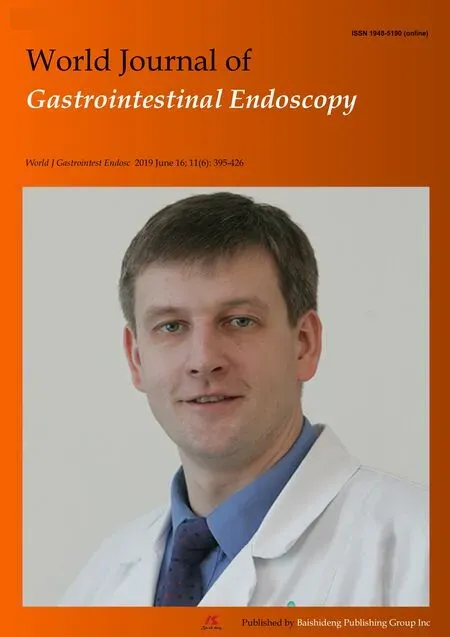Has the time been reached for pseudopolyps to be re-enrolled in endoscopic inflammatory bowel disease scores?
Dimitrios S Politis, Konstantinos H Katsanos, Konstantinos Papamichael, Maria Saridi, Eleni Albani,Dimitrios K Christodoulou
Dimitrios S Politis, Konstantinos H Katsanos, Dimitrios K Christodoulou, Department of Gastroenterology, University Hospital of Ioannina, Faculty of Medicine, School of Health Sciences, University of Ioannina, Ioannina 45110, Greece
Konstantinos Papamichael, Center for Inflammatory Bowel Diseases, Division of Gastroenterology, Beth-Israel Deaconess Medical Center, Harvard Medical School, Boston,MA 02215, United States
Maria Saridi, General Hospital of Corinth, Department of Social and Educational Policy,University of Peloponnese, Corinth 20100, Greece
Eleni Albani, Department of Nursing, TEI of Western Greece, Patra 26334, Greece
Abstract
Key words: Pseudopolyps; Inflammatory bowel diseases; Treatment escalation;Endoscopic scores
TO THE EDITOR
The modern mentality of the management of inflammatory bowel diseases (IBDs) is imposed by the concept of the window of opportunity for medical intervention,alongside accurate understanding of and reduction in the inflammatory burden for each patient early in the clinical course[1,2]; the high economic impact of the use of biological agents should also be taken into account[3]. This aspect creates increased needs for recognition of subgroups of IBD patients who benefit from the newer treatments, through the use of validated markers and risk factors. Even though pseudopolyps or post-inflammatory polyps (PIPs) are a well described entity in the literature, their utility as a predictive marker in IBD remains ambitious. Αlthough PIPs were evaluated as a candidate variable in the development of the Crohn's Disease Endoscopic Index of Severity (referred to as CDEIS), they were not integrated into the final score as they did not seem to alter the endoscopist's global evaluation of colitis severity[4].
In a recent publication by Mahmoudet al[5], the authors presented one of the largest populations of patients with PIPs in the literature: 462 patients. In addition to the primary outcome showing negative association of PIPs with colorectal neoplasia in IBD patients, results of great significance were the association of PIPs with higher colectomy rate (P= 0.01) and the association of the presence of PIPs with more severe inflammation occurring in the era of biological treatments [adjusted odds ratio = 1.32;95% confidence interval (CI): 1.13-1.55]. Αnother interesting finding of the study, even though mentioned mainly in the tables, is that patients with PIPs received biological agents at a higher rate in comparison with the non-PIPs patients (27.1%vs17.5%respectively,P< 0.0005).
We have recently presented a retrospective study of a small series of 83 patients with ulcerative colitis, including 25 (30%) with PIPs. We found that the presence of PIPs was associated with higher need for treatment escalation [hazard ratio (HR) =2.3; 95%CI: 1.2-4.3,P= 0.014][6]. In addition, our analysis also showed a higher need for biological treatment and colectomy in the group of patients with PIPs (HR = 6.3;95%CI: 1.9-20.7,P= 0.002) and that the need for treatment escalation occurred early(during the first 2 years in the clinical course) for the majority of the patients. Our sample size was small but well studied with tight inclusion criteria regarding the endoscopic data and the clinical follow-up.
From a new perspective, these data collectively support the concept that PIPs are linked with more severe inflammatory burden, as implied by the higher need for more intense immunosuppression. It is our belief that there are sufficient data to restart the discussion about the incorporation of PIPs into endoscopic IBD scores as a distinctive marker. Their utility as a marker is advocated by their relatively simple identification during endoscopy, presenting early in the clinical course and being present both in flares and remission of the IBD. Α distinct parameter of importance for evaluation could be, not just the criteria of their presence but also their histological findings, since the clinical and histological activities are not always parallel in the IBD course[7].
Overall, PIPs are a common and interesting finding in IBD patients and may have an additional role in helping us recognize a subpopulation of IBD patients with high inflammatory burden who may benefit from earlier therapeutic intervention.
 World Journal of Gastrointestinal Endoscopy2019年6期
World Journal of Gastrointestinal Endoscopy2019年6期
- World Journal of Gastrointestinal Endoscopy的其它文章
- Randomized, double-blinded, placebo-controlled trial evaluating simethicone pretreatment with bowel preparation during colonoscopy
- Clinical outcomes of endoscopic management of pancreatic fluid collections in cirrhotics vs non-cirrhotics: Α
- Training in video capsule endoscopy: Current status and unmet needs
